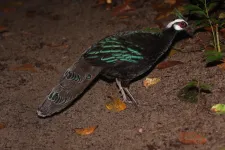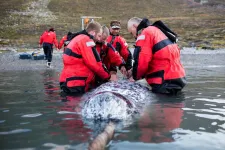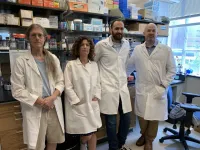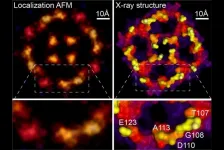INFORMATION:
Editor's notes: To contact Eunice E. Santos, email eesantos@illinois.edu.
The paper "Analyzing medical guideline dissemination behaviors using culturally infused agent based modeling framework" is available online and from the U. of I. News Bureau.
DOI: 10.1109/JBHI.2021.3052809
Model helps analyze decision-making on adopting Type 2 diabetes medical guidelines
A new computational framework incorporates social interactions to analyze how best to communicate about new medical guidelines to encourage their adoption
2021-06-16
(Press-News.org) CHAMPAIGN, Ill. -- Health care workers often don't adopt new guidelines for best practices in medical care until well after those guidelines are established. A team of researchers led by Eunice E. Santos, the dean of the School of Information Sciences at the University of Illinois Urbana-Champaign, has developed a new computational modeling and simulation framework to analyze decision-making and identify effective dissemination strategies for medical guidelines.
The research team examined guidelines for Type 2 diabetes that were established in 2012 and were still not adopted years later. The researchers found that health care workers' specialties, patient volume and experience were among the factors that affected acceptance of individualized glycemic-control guidelines.
The team developed a novel computational framework that incorporates the interactions and influences among health care workers, along with other intricacies of medical decision-making, to simulate and analyze a wide range of real-world scenarios. Researchers introduced the Culturally Infused Agent Based Model (CI-ABM) and reported their findings in the cover article for the June issue of the IEEE Journal of Biomedical and Health Informatics.
Their research highlights that modeling and simulating human behaviors must take into account factors such as sociocultural context and complex social interactions, without which the models can lead to a profound misunderstanding of human decision-making, they said.
"One of the major challenges is capturing the decision-making of the actors and the factors that influence them. This is especially true when the agents are human beings (e.g., health care workers), where their behavior is uncertain and the information about the factors that influence their decision-making is often incomplete and/or contradictory," they wrote.
The modeling system they developed incorporates social networks and cultural influences that guide decision-making, and it captures how beliefs evolve over time due to personal and external factors. It provides that ability to model real-world events that involve incomplete, imprecise and conflicting information, and it provides a way to handle uncertainty in human behavior. These aspects of their computational model led to better analysis and prediction of guideline-dissemination behaviors, the researchers said.
Santos and her colleagues used the model to analyze the dissemination of a Type 2 diabetes guideline that recommends individualizing glycemic goals for patients. Diabetes care guidelines since 2012 have emphasized individualizing glycemic goals based on patient factors such as age, hypoglycemia risk and overall health. But it isn't known how many doctors have adopted this guideline.
The researchers used two 2015 surveys that focused on challenges faced by doctors in individualizing the glycemic goals of their patients. The surveys included doctors from diverse backgrounds and a range of specialties - including endocrinology, family medicine and geriatrics - experience levels and practice types.
In their simulation, some of the doctors received guideline recommendations from the American Diabetes Association. Best practices also spread through word-of-mouth. The team compared the results of the simulations with the answers given on the surveys. The researchers found that including sociocultural factors and information about social interactions of health care workers in their model increased the accuracy of predicting guideline-adoption behaviors of various demographic groups. In addition, by including sociocultural information, the model helps to identify factors that drive guideline-adoption behavior.
The framework also allows policymakers to study the effect of different barriers to disseminating medical guideline information, identify the factors contributing to guideline adoption and create targeted strategies to improve communication about the guidelines, they said.
The modeling system will help policymakers test different strategies and analyze their effects, the researchers said. It provides a way to capture the effect of unique factors - for example, when modeling guideline dissemination for infectious diseases, it can help analyze the effects of incorporating information about the novelty and mortality of infectious diseases, as well as the impact of changes in social networks due to lockdowns.
The team of researchers included Suresh Subramanian and Vairavan Murugappan, both doctoral students in Illinois' School of Information Sciences; John Korah, a computer science professor at California State Polytechnic University; Elbert S. Huang and Neda Laiteerapong, both professors of medicine at The University of Chicago Medicine; and Ali Cinar, a chemical and biological engineering professor at the Illinois Institute of Technology.
ELSE PRESS RELEASES FROM THIS DATE:
What factors put Philippine birds at risk of extinction?
2021-06-16
The lush forests and more than 7,000 islands of the Philippines hold a rich diversity of life, with 258 bird species who live nowhere but the Philippine archipelago. A new study from University of Utah researchers suggests that, due to deforestation and habitat degradation, more bird species may be endangered that previously thought - including species that may not have been discovered yet. The study is published in Frontiers in Ecology and Evolution.
"Our study provides a roadmap for not only which species may warrant heightened conservation attention," says Kyle Kittelberger, a doctoral student in the University of Utah School of Biological Sciences, "but which traits ...
Algorithm reveals the mysterious foraging habits of narwhals
2021-06-16
An algorithm can predict when narwhals hunt - a task once nearly impossible to gain insight into. Mathematicians and computer scientists at the University of Copenhagen, together with marine biologists in Greenland, have made progress in gathering knowledge about this enigmatic Arctic whale at a time when climate change is pressuring them.
The small whale, known for its distinctively spiraled tusk, is under mounting pressure due to warming waters and the subsequent increase in Arctic shipping traffic. To better care for narwhals, we need to learn more about their foraging behaviour - and how these may change as a result of human disturbances and global warming. Biologists know almost nothing about this. Because narwhals live in isolated Arctic regions and ...
Smartphone bans in the workplace
2021-06-16
For many of us, our smartphone has become our ever-present companion and is usually far more than just a phone. Thanks to the constant availability of online content as well as our reachability through messenger services and social networks via our smartphone, this everyday object's potential to distract us is high - at work too. This is why many employers view the use of smartphones during work time with suspicion, and countermeasures taken range from asking staff to refrain voluntarily from using them to banning smartphones in the workplace through an internal agreement. But do such measures actually work and, if so, how?
This is the ...
Sweeping analysis concludes there's no cheating old age
2021-06-16
DURHAM, N.C. - Special diets, exercise programs, supplements and vitamins -- everywhere we look there is something supposed to help us live longer. Maybe those work: human average life expectancy has gone from a meager 40-ish years to a whopping 70-something since 1850. Does this mean we are slowing down death?
A new study comparing data from nine human populations and 30 populations of non-human primates says that we are probably not cheating the reaper. The researchers say the increase in human life expectancy is more likely the statistical outcome of improved survival for children and young adults, not slowing the aging clock.
"Populations get older mostly because more individuals get through those early stages of life," ...
Stoneflies: Youth influences adulthood
2021-06-16
In the majority of insects, metamorphosis fosters completely different looking larval and adult stages. For example, adult butterflies are completely different from their larval counterparts, termed caterpillars. This "decoupling" of life stages is thought to allow for adaptation to different environments. Researchers of the University of Bonn now falsified this text book knowledge of evolutionary theory for stoneflies. They found that the ecology of the larvae largely determines the morphology of the adults by investigating 219 earwig and stonefly species at high-resolution particle accelerators. The study has ...
Osteoporosis: New approach to understanding bone strength pays dividends
2021-06-16
Osteoporosis researchers at the UVA School of Medicine have taken a new approach to understanding how our genes determine the strength of our bones, allowing them to identify several genes not previously known to influence bone density and, ultimately, our risk of fracture.
The work offers important insights into osteoporosis, a condition that affects 10 million Americans, and it provides scientists potential new targets in their battle against the brittle-bone disease.
Importantly, the approach uses a newly created population of laboratory mice that allows researchers to identify relevant genes and overcome limitations of human studies. Identifying such genes has been very difficult but is key to using genetic discoveries to improve ...
Icebergs drifting from Canada to southern Florida
2021-06-16
Woods Hole, MA (June 16, 2021) -- Woods Hole Oceanographic Institution (WHOI) climate modeler Dr. Alan Condron and United States Geological Survey (USGS) research geologist Dr. Jenna Hill have found evidence that massive icebergs from roughly 31,000 years ago drifted more than 5000km (> 3,000 miles) along the eastern United States coast from Northeast Canada all the way to southern Florida. These findings were published today in Nature Communications.
Using high resolution seafloor mapping, radiocarbon dating and a new iceberg model, the team analyzed about 700 iceberg scours ("plow marks" on the seafloor left behind by the bottom parts of icebergs dragging through marine sediment ) from Cape Hatteras, North Carolina to the Florida Keys. ...
Yeast mating -- more than meets the eye
2021-06-16
Researchers from the Max-Planck Institute for Terrestrial Microbiology have discovered a surprising asymmetry in the mating behavior of unicellular yeast that emerges solely from molecular differences in pheromone signaling. Their results, published in the current issue of "Science Advances", might shed new light on the evolutionary origins of sexual dimorphism in higher eukaryotes.
Resemblant of higher organisms, yeast gametes communicate during the mating process by secreting and sensing sexual pheromones. However, in contrast to higher eukaryotes, budding yeast is isogamous: seen through a microscope, gametes of both mating types ("sexes"), MATa and MATα, look exactly the same. Since anisogamy -- difference in size between male and female gametes --was ...
MD Anderson research highlights for June 16, 2021
2021-06-16
HOUSTON ? The University of Texas MD Anderson Cancer Center's Research Highlights provides a glimpse into recently published studies in basic, translational and clinical cancer research from MD Anderson experts. Current advances include a new combination therapy for acute myeloid leukemia (AML), a greater understanding of persistent conditions after AML remission, the discovery of a universal biomarker for exosomes, the identification of a tumor suppressor gene in hepatocellular carcinoma (HCC) and characterization of a new target to treat Clostridioides difficile (C. difficile) infections.
Utilizing combination therapy for AML
While a majority of patients with acute myeloid leukemia (AML) respond favorably ...
New super-resolution microscopy method approaches the atomic scale
2021-06-16
Scientists at Weill Cornell Medicine have developed a computational technique that greatly increases the resolution of atomic force microscopy, a specialized type of microscope that "feels" the atoms at a surface. The method reveals atomic-level details on proteins and other biological structures under normal physiological conditions, opening a new window on cell biology, virology and other microscopic processes.
In a study, published June 16 in Nature, the investigators describe the new technique, which is based on a strategy used to improve resolution in light microscopy.
To study proteins and other biomolecules at high resolution, investigators have long relied on two techniques: X-ray crystallography ...
LAST 30 PRESS RELEASES:
Reviving dormant immunity: Millimeter waves reprogram the immunosuppressive microenvironment to potentiate immunotherapy without obvious side effects
Safety decision-making for autonomous vehicles integrating passenger physiological states by fNIRS
Fires could emit more air pollution than previously estimated
A new way to map how cells choose their fate
Numbers in our sights affect how we perceive space
SIMJ announces global collaborative book project in commemoration of its 75th anniversary
Air pollution exposure and birth weight
Obstructive sleep apnea risk and mental health conditions among older adults
How talking slows eye movements behind the wheel
The Ceramic Society of Japan’s Oxoate Ceramics Research Association launches new international book project
Heart-brain connection: international study reveals the role of the vagus nerve in keeping the heart young
Researchers identify Rb1 as a predictive biomarker for a new therapeutic strategy in some breast cancers
Survey reveals ethical gaps slowing AI adoption in pediatric surgery
Stimulant ADHD medications work differently than thought
AI overestimates how smart people are, according to HSE economists
HSE researchers create genome-wide map of quadruplexes
Scientists boost cell "powerhouses" to burn more calories
Automatic label checking: The missing step in making reliable medical AI
Low daily alcohol intake linked to 50% heightened mouth cancer risk in India
American Meteorological Society announces Rick Spinrad as 2026 President-Elect
Biomass-based carbon capture spotlighted in newly released global climate webinar recording
Illuminating invisible nano pollutants: advanced bioimaging tracks the full journey of emerging nanoscale contaminants in living systems
How does age affect recovery from spinal cord injury?
Novel AI tool offers prognosis for patients with head and neck cancer
Fathers’ microplastic exposure tied to their children’s metabolic problems
Research validates laboratory model for studying high-grade serous ovarian cancer
SIR 2026 delivers transformative breakthroughs in minimally invasive medicine to improve patient care
Stem Cell Reports most downloaded papers of 2025 highlight the breadth and impact of stem cell research
Oxford-led study estimates NHS spends around 3% of its primary and secondary care budget on the health impacts of heat and cold in England
A researcher’s long quest leads to a smart composite breakthrough
[Press-News.org] Model helps analyze decision-making on adopting Type 2 diabetes medical guidelinesA new computational framework incorporates social interactions to analyze how best to communicate about new medical guidelines to encourage their adoption








